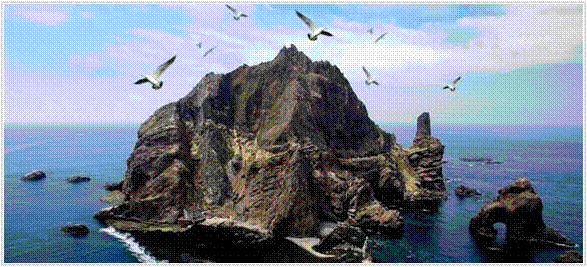Collection
Korean History in the Eyes of the Dokdo

Dokdo, a group of Korea's easternmost islands, is off of the Korean peninsula in the East Sea. The address of Dokdo is 1~96 Dokdo-ri, Ulleung-eup, Ulleung-gun, Gyeongsangbuk-do. It is located 216.8km east of Jukbyeon, Uljin-gun, Gyeongsangbuk-do and 87.4km southeast of Ulleungdo (Ulleung Island). According to the Joseon Dynasty era book, Sejong Sillok Jiriji ("Geographical Records in the Annals of King Sejong"), on a clear day Dokdo could be seen from Ulleungdo with the naked eye. Dokdo consists of two larger islands, known as Dongdo (East Island) and Seodo (West Island), and 89 smaller islets. The shortest distance between Dongdo and Seodo is 151m (495.4 feet) at low tide, and the total area of Dokdo is 187,554㎡ (45.35 acres): Dongdo is 73,297㎡ (18.11 acres), Seo-do is 88,740㎡ (21.93 acres), and the other smaller islets combined are 25,517㎡ (6.31 acres).
Because the only way to get to Dokdo is by boat from Ulleungdo, good weather is essential. The islands of Dokdo enjoy a maritime climate with an average annual temperate of 12°C (53.6°F) due to the warm ocean currents. As a result, Dokdo has a relatively mild climate. The lowest temperatures occur in January, when the average temperature is 1°C (33.8°F), while the highest temperatures are in August, when it averages 23°C (73.4°F). On the windy islands of Dokdo, the average wind speed is 4.3m/s. In the summer, the southwest winds prevail, while in the winter the northeast wind is more dominant.
We have so far only looked at the modern aspects of Dokdo. But since when has Dokdo been recognized as a part of Korean territory? Throughout Korea's history, Dokdo has been known by several names, like Usando and Gajido. The islands were also named after the various ships that stumbled across it. For example, Dokdo was named Liancourt Rocks after a French whaling ship, Hornet Rocks after a British ship, and Menalai-Olivutsa by the Russians. The historical maps and documents in this collection, which also include historical Western maps, will help us understand how Dokdo was viewed by both Korea and other nations in the past and in modern times.
To learn how Dokdo was perceived in the past and understand the more recent Dokdo dispute, we will take a look at historical documents and materials dating back to when Dokdo became a part of the Silla Dynasty through the end of World War II. Prior to Japan's recent revision of social studies textbooks, Korea was more willing to disregard Japan's tenacious territorial claims over Dokdo. However, because Korea now realizes that it must be more assertive in proving its claim to Dokdo, we will explore the reasons behind Japan's assertions and point out the weaknesses in their stance. Let's explore the evidence that will prove Korea's claim over Dokdo to the international community.
 This website is the official e-government website of Korea.
This website is the official e-government website of Korea.
